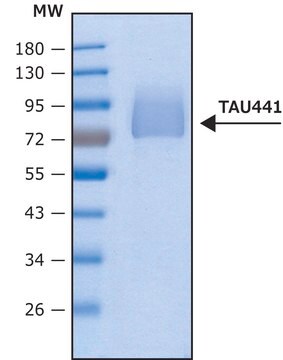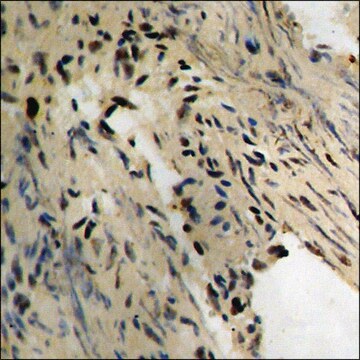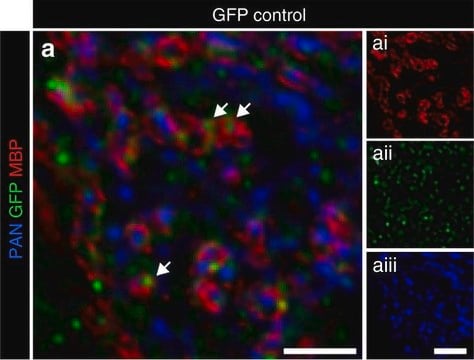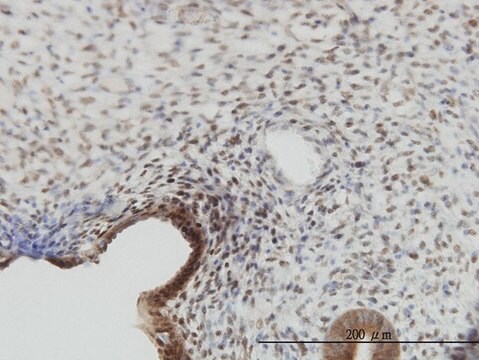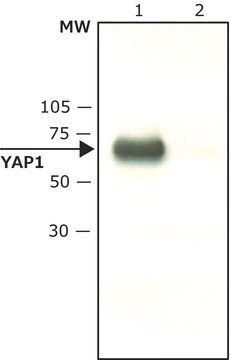MABN2275
Anti-phospho-Tau (Ser235) Antibody, clone RN235
clone RN235, from mouse
Sinonimo/i:
Microtubule-associated protein tau, Neurofibrillary tangle protein, Paired helical filament-tau, PHF-tau
About This Item
ELISA
IF
IHC
WB
dot blot: suitable
immunofluorescence: suitable
immunohistochemistry: suitable (paraffin)
western blot: suitable
Prodotti consigliati
Origine biologica
mouse
Forma dell’anticorpo
purified immunoglobulin
Tipo di anticorpo
primary antibodies
Clone
RN235, monoclonal
Reattività contro le specie
mouse, human
Confezionamento
antibody small pack of 25 μg
tecniche
ELISA: suitable
dot blot: suitable
immunofluorescence: suitable
immunohistochemistry: suitable (paraffin)
western blot: suitable
Isotipo
IgG1κ
N° accesso NCBI
N° accesso UniProt
modifica post-traduzionali bersaglio
phosphorylation (pSer235)
Informazioni sul gene
human ... MAPT(4137)
Descrizione generale
Specificità
Immunogeno
Applicazioni
Dot Blot analysis: A representative lot detected phosphorylated recombinant human tau (pSer235), but not the non-phosphorylated recombinant human tau (Tau). (Courtesy of Rebecca Nisbet, Ph.D., University of Queensland, Brisbane, Austraila).
Immunofluorescence Analysis: A representative lot detected phospho-tau (Ser235) in K3 and rTg4510 tau transgenic mouse brains (Courtesy of Rebecca Nisbet, Ph.D., University of Queensland, Brisbane, Austraila).
Immunohistochemistry (Paraffin) Analysis: A representative lot detected phospho-Tau (Ser235) in human Alzheimer s disease (AD) brain tissue sections. (Courtesy of Rebecca Nisbet, Ph.D., University of Queensland, Brisbane, Austraila).
ELISA Analysis: A representative lot full-length human recombinant phospho-tau (Ser235) or GSK-3 beta phosphorylated tau (pTau), but not the non-phosphorylated tau (Courtesy of Rebecca Nisbet, Ph.D., University of Queensland, Brisbane, Austraila).
Western Blotting Analysis: A representative lot detected phospho-tau (pSer235) K3 tau transgenic mouse brain homogenates, but not in homogenates from tau knock-out (KO) (Courtesy of Rebecca Nisbet, Ph.D., University of Queensland, Brisbane, Austraila).
Neuroscience
Qualità
Western Blotting Analysis: 2 µg/mL of this antibody detected Microtubule-associated protein tau (pSer235) in brain tissue lysates from K3 transgenic mouse, but not in brain of microtubule-associated protein tau (MAPT) knock out mouse.
Descrizione del bersaglio
Stato fisico
Stoccaggio e stabilità
Altre note
Esclusione di responsabilità
Non trovi il prodotto giusto?
Prova il nostro Motore di ricerca dei prodotti.
Codice della classe di stoccaggio
12 - Non Combustible Liquids
Classe di pericolosità dell'acqua (WGK)
WGK 1
Punto d’infiammabilità (°F)
Not applicable
Punto d’infiammabilità (°C)
Not applicable
Certificati d'analisi (COA)
Cerca il Certificati d'analisi (COA) digitando il numero di lotto/batch corrispondente. I numeri di lotto o di batch sono stampati sull'etichetta dei prodotti dopo la parola ‘Lotto’ o ‘Batch’.
Possiedi già questo prodotto?
I documenti relativi ai prodotti acquistati recentemente sono disponibili nell’Archivio dei documenti.
Il team dei nostri ricercatori vanta grande esperienza in tutte le aree della ricerca quali Life Science, scienza dei materiali, sintesi chimica, cromatografia, discipline analitiche, ecc..
Contatta l'Assistenza Tecnica.
